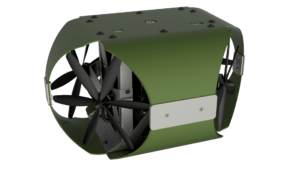
According to an official press release, BMT has achieved a significant milestone in autonomous drone technology with its SPARO® project, which has received funding from the British Army’s Futures Directorate. This initiative aims to enhance the delivery of medical supplies using drones, which was demonstrated in the Project CONVERGENCE exercise with the US Army.
The BMT SPARO® device represents a globally novel approach by enabling drones to operate at a considerable height, thereby reducing the risks associated with low-flying drones in populated or sensitive areas. This technology is particularly advantageous in hostile environments where traditional delivery methods are impractical.
James Campbell, the Emerging Products Manager at BMT, remarked on the project’s evolution, “BMT SPARO®’s progression since 2019, and its initial acceptance from a government-customer, signals the dawn of a new type of robot: a small, safe, and quiet device suspended under a logistics aircraft that takes over responsibility for payload delivery, better suited to challenging and sensitive environments.”
The project’s recent funding is poised to accelerate the commercialization of BMT SPARO®, facilitating broader applications beyond military uses. Phil Metcalfe, Regional Business Director for UK and Europe at BMT, highlighted the practical benefits of this innovation, saying, “As drone technology and its use in challenging situations accelerates, BMT’s SPARO® autonomous delivery device is a safe, simple and cost-effective solution to the problem of using drones to deliver payloads in difficult environments.”
Dr. Steve Wright from Wright Airborne Computing reflected on the broader implications of such technological advancements. “During 30 years of working in aerospace, I have not seen anything like the surge in new aircraft, systems, and applications that has happened in the last five years,” he stated.
The SPARO® device operates by safely transferring payloads from an aircraft to precise ground locations, facilitated by onboard sensors, power, and processing capabilities. It also incorporates a compact internal winch and small side-facing fans to control its positioning.
Beyond military applications, there is potential for BMT SPARO®’s technology to be adapted for civilian uses such as manned helicopter operations, maritime deliveries, emergency services, and e-commerce. The ongoing development and discussions with established suppliers underscore BMT’s commitment to pioneering solutions that could revolutionize autonomous logistics.
Read more:
- BMT’s Patent for the SPARROW Could Change Military Drone Delivery [VIDEO]
- Drone Delivery in 2024: A Balanced Perspective
- Small Drones Can Fly Ahead of Military Units to Detect CBRN Hazards: Draper Develops New Capabilities

Miriam McNabb is the Editor-in-Chief of DRONELIFE and CEO of JobForDrones, a professional drone services marketplace, and a fascinated observer of the emerging drone industry and the regulatory environment for drones. Miriam has penned over 3,000 articles focused on the commercial drone space and is an international speaker and recognized figure in the industry. Miriam has a degree from the University of Chicago and over 20 years of experience in high tech sales and marketing for new technologies.
For drone industry consulting or writing, Email Miriam.
TWITTER:@spaldingbarker
Subscribe to DroneLife here.